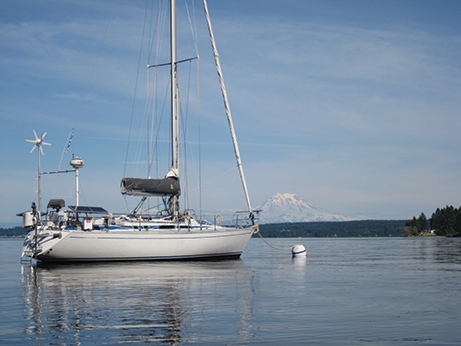How to harness the elements to keep your boat’s systems running smoothly and your life aboard more pleasant (published November 2014)
From the climates of tropical beaches to high latitudes fjords, cruisers crave the sun, wind and water. And with that, we delight in our ability to live a simple, self-sufficient life aboard that allows us to get out and enjoy the places we have taken so much time and effort to sail to.
Part of that self-supporting satisfaction comes from not being fully dependent on outside sources for power. By running a generator or engine to charge our systems, we use fuel and oil, which require replenishment. Plus, we put wear and tear on both pieces of equipment that causes us to carry a bevy of spare parts for the moment when the attrition turns into failure.
By installing solar, wind and water systems to generate power for us, we are decreasing our reliance on our engine systems for power generation and, in turn, are living a cleaner, less noisy and happier life aboard.
On the cruising boats that we have in the BWS family, we have seen how this works in real life and are pleased to bring you this guide to your own energy independence.
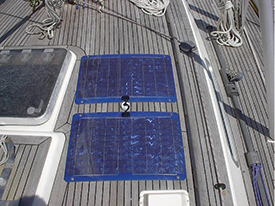
GO SOLAR
Most cruisers have at least a vague notion of what a solar panel will do; the sun shines, the panel absorbs it and turns into power, which is then stored in your batteries for use aboard. This seems fairly basic, so going out and adding solar panels to your boat should be too, right? Unfortunately, simply buying a new solar panel or two and mounting them on your boat isn’t as easy as it sounds. As many sailors have found out, the process of adding a solar array to your boat can be an intimidating process full of questions and decisions that need to be made before plunking down a bunch of hard-earned cash.
For starters, there are two main variables that need to be considered when adding a solar array to your cruising boat: How much power do you need to generate, and how much space do you have available for the actual panels? From there you can select the panels that are right for you and the necessary components to make them operational and efficient.
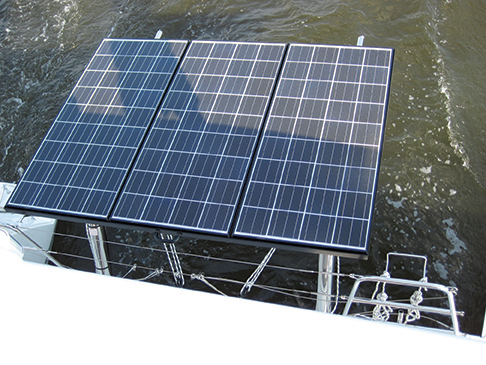
SIZE MATTERS
When deciding to go solar, the first thing you need to do is to figure out how much power you are using during an average day of cruising. This can be done by making a quick graph including each appliance and how many amps they use per hour, how many hours you plan to use them per day and then how many watts that turns into on a 12-volt system.
Example: If an anchor light draws one amp per hour and is run for eight hours it will use 96 watts (8 amps x 12 volts = 96 watts).
Solar panels are rated in watts so once you have determined how many watts you use, you can figure out how big your solar array needs to be. It is recommended that you exceed those requirements by 20 percent for a fully self-reliant solar system.
You also need to think about what type of cruising you are going to be doing with your new panels. Are you mostly going out for weekends and a few weeks a year and just want to reduce your engine hours? Or are you a full-time cruiser who is planning to spend most of your non-passagemaking time at anchor? Plus, how big is your current house battery bank?
We spoke with Bob Everhard from eMarine Systems (emarineinc.com) in Fort Lauderdale, Florida to get the scoop on how cruisers are outfitting with solar and he explained that choosing a solar array is as much about the size of your battery bank as it is with how much you are taking out each day. “Five hundred Amperes is what a typical cruising boat carries these days, but up to 700 is better, and not uncommon,” he explained. “And if you are running a refrigerator compressor or two, those will be the largest energy consumers aboard, so you need to plan accordingly.”
A recent survey of Cruising Compass readers who own solar panels revealed that the majority of respondents use solar power to cover 100 percent of their onboard energy needs. This suggests that cruisers heavily value solar power to keep their batteries topped up and systems running. And it makes sense, because if you are going to spend the money and put the effort into installing solar panels, you might as well cover most or all of your energy requirements.
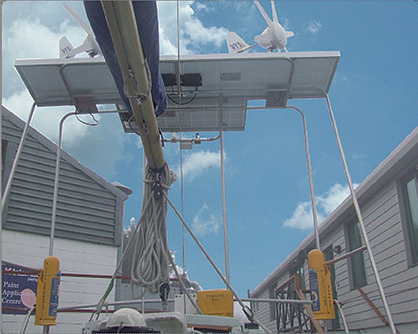
MOUNT UP
One of the hardest choices to make when purchasing new solar panels is where to house them, which was one of the first hurdles Bob pointed to for perspective solar seekers. “The most popular place to mount panels is on top of the Bimini, davits or arch, and on top of a hard dodger,” Bob explained, “but there really is no one perfect solution for everyone.”
Boats are as different as their owners and where one cruiser may like to mount a solar panel could be completely different from another. Deciding on a place to put your panels is all about getting maximum sun exposure and can determine whether you choose to go with rigid or semi-flexible panels. Rigid panels are durable and can be mounted in a number of places, but if you want to remove them for storm preparation or to drop your Bimini back while sailing, then you’re going to have to take that into consideration.
Oftentimes mounting panels above davits or on a stern arch can be the best place, as it will get them farther aft away from the main part of the cockpit and out from under the boom and mainsail. Another option is to mount them as foldable wings off either side of the cockpit, though this can clutter up your pushpit or require you to install a rigid rail from the pushpit forward.
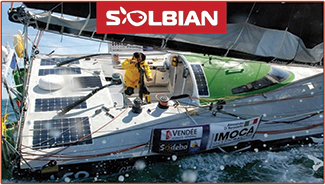
The other thing to keep in mind when mounting your panels is the wiring. Make sure to use marine grade wire and a quality charge controller with settings for your specific type of batteries so you don’t end up frying what you have. Also, install a fuse from the positive lead to your panels and get a voltmeter so you can keep an eye on how much your solar panels are putting into your battery bank.
PANEL TYPES
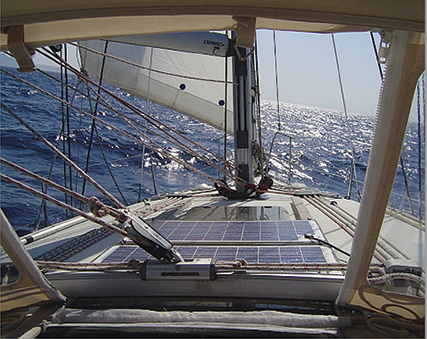
Choosing the type of solar panel that is right for your boat will involve decisions made above about how much power you require and where you are able to put your panels, plus, how much you want to spend and what type of longevity and warranty you are looking to get. Fortunately, the price of solar panels and their components has dropped in recent years, while the quality has gone up, so obtaining a good setup isn’t the steep financial hit that it once was.
There are three main types of solar panels on the market to today: monocrystalline, multicrystalline (polycrystalline) cells and amorphous silicon. What we gleaned from our conversation with Bob is that consumers are really going to be thinking about the panels in two forms: rigid or flexible.
Rigid panels fall in the first two categories on the market and are popular because they are durable, can last as long as 25 years and come with a warranty of 10 years. Flexible panels aren’t necessarily any less durable, but they typically don’t last as long and because of that, come with a shorter warranty.
Price is also a factor in purchasing solar panels and it seems that online prices are relatively cheaper than walking into any marine store to buy the same setup. Like any major purchase you make for your boat, it is best to shop around and do some quality homework before making a large commitment.
WIND POWER
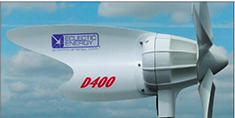 Wind mills have been a part of the human energy equation since around the first century AD and have played a vital role in agriculture and energy generation ever since. Lately, the move to sustainable energy systems has advanced windmill design and created along the way a new generation of wind generators that can be adapted for use on a cruising boat.
Wind mills have been a part of the human energy equation since around the first century AD and have played a vital role in agriculture and energy generation ever since. Lately, the move to sustainable energy systems has advanced windmill design and created along the way a new generation of wind generators that can be adapted for use on a cruising boat.
While wind generators can be effective tools for keeping our batteries topped up, particularly if you are living and cruising in areas where there are consistant fresh winds, such as in the trade winds in the tropics or the high latitudes, but they do come with the associated noise they make when spinning.
So when you are thinking about adding a wind generator to your boat, you have to factor in more than just the amount of energy it will create. You have to consider the annoyance factor of living with a contraption that whirrs. And you will want to consider how it affects you neighbors in an anchorage, too.
There are three basic types of wind generators: large two-blade units, smaller three blade designs and the even smaller five and six blade devices. Each has its place aboard a cruising boat.
TWO BLADES
Two bladed units are not as common today as they were a generation ago since more modern designs and innovations have created smaller and lighter options. The standard two-bladed unit will have a blade span or diameter of 60 inches or more. This size means the unit has to be mounted at least 12 feet above the deck. One popular option is to not mount the unit on a pole but suspend it in the fore triangle when you want to generate electricity and stow it away when you are underway. Some two blade units can double as water generators so having the unit be demountable and portable increases your charging options.
Large diameter wind generators will start to generate in as little as 5 knots of breeze and will be almost silent until the wind gets above 15 knots. Above 15, you will hear a steady whoosh from the blades but not anything too annoying, particularly since you will be creating a huge charge for the battery bank. In 15 knots of breeze, these units can generate 250 watts or more.
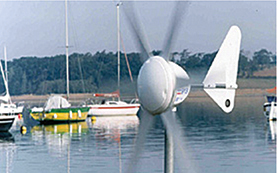
THREE BLADES
The three bladed wind generators that came into vogue about 20 years ago were designed to be pole mounted and to operate in a wide range of wind speeds. The development of highly aerodynamic blades that could be injection molded and the light weight, streamlined aluminum housings, reduced weight and cost and made permanently mounted generators more accessible to the cruising fleet. It is common in the cruising hot spots such as Georgetown, Exuma, Bahamas, to see several hundred boats riding at anchor with their wind generators spinning away. In a fresh breeze, the sound becomes ambient.
All thee-bladed wind generators are not equal. The less expensive models which have become so popular have their regulators or charge controllers built into the unit’s housing where it “self regulates” the charge that is fed to the battery banks. While this sounds like a good idea, history has proven that an external charge controller is a better solution.
Blades are also an area where you will find that you get what you pay for. The inexpensive roto molded blades tend to fray at the tips over time and as they do the whir tends to increase. There are models out there that have high density blades and external charge controllers that are very worth looking at.
 The three blade units can be amazingly productive but do not really start generating anything significant until the breeze gets over 10 knots. Some brands are better at low speeds than others but the sweet spot for most of the three-bladed units is between 10 and 30 knots. The units are rated in watts and the most popular models generate between 150 and 600 watts. One model claims to have a maximum output of 1000 watts. These sound like very high numbers but you have to remember that the charge controller will match the generator’s output to the state of charge of your battery bank.
The three blade units can be amazingly productive but do not really start generating anything significant until the breeze gets over 10 knots. Some brands are better at low speeds than others but the sweet spot for most of the three-bladed units is between 10 and 30 knots. The units are rated in watts and the most popular models generate between 150 and 600 watts. One model claims to have a maximum output of 1000 watts. These sound like very high numbers but you have to remember that the charge controller will match the generator’s output to the state of charge of your battery bank.
FIVE AND SIX BLADES
The smaller diameter units with five or six blades have two immediate advantages over the two-blade and three-blade designs: they are smaller and much quieter. There are several brands of these multi-blade units that have been out in the cruising fleets for many years.
Because most of these units are smaller, they do not present such a large profile on a aft pole or on your cockpit arch. It is common on larger boats to see two of these units spinning away silently day and night.
The downside of most of the smaller units is the poorer light wind performance and the smaller overall output in all conditions. Although there are exceptions, you will find that in 10 knots of breeze the six blade units will generate about 25 watts while one of the better and larger five bladed units will provide 10 times that much at about 250 watts.
The trade off when choosing a five or six blade generator is size and silence versus performance and slightly more whirring. Many cruisers have chosen the latter because the whir of a five blade unit is significantly less than the sound of a three bladed generator.
WATER POWER
Generating power for the house battery bank directly from the speed of the boat moving through the water is a novel and ingenious solution to self-sufficiency and sustainability. The technology works by towing a propeller behind the boat. As the water passes the propeller, it turns and drives the generator that is mounted on the stern. It is a simple system that can generate enough power to run the boat while at sea.
Two of the units that are on the market can be used as either a wind generator or a water generator. That way, while you are at sea you tow the propeller to charge the batteries and while anchored, you convert the unit into a windmill to generate power with the breeze.
Recently, a new type of hydrogenertor was introduced that fits onto the transom of cruising boats almost like an outboard motor. The shaft has a prop at its end that drives a generator at the top of the unit. The shaft can be lowered and raised easily with a block and tackle. An elegant and purpose built solution to water generation, the new hydrogenerators can really keep your batteries topped up at sea.
Water generators will kick off between 100 and 400 watts at normal sailing speeds. Boats that can sail at 10 knots or more will find that their generators are producing upward of 600 watts. But, of course, depending on the size of the battery bank and the daily draw, a lot of this generating power is wasted.

CONCLUSION
What is the right solution for maintaining sustainable alternate energy sources on your boat that keep the batteries topped up and reduce your boat’s energy footprint?
Solar panels are the best place to start. If you have a catamaran then you can lay out a large array of panels that will spend six to eight hours a day generating juice. That might be all you need to be self-sufficient.
On monohulls, space is more of a premium so a large array of panels may not be possible. But if you can get 150 watts or so on the Bimini or davits, you will have a great head start on the problem.
Then, you will want to look at adding a wind generator. Depending on your boat and the amount you draw against your batteries, the size and sound of the wind generator can be established. Your preference may be for the largest unit available to be a complete replacement for the solar panels when the sun is hidden by clouds. Or, you may choose a five or six blade model that is quiet, small and can provide a regular charge as long as the wind blows. Your neighbors in the anchorage will be happy with this decision.
Lastly, for cruisers who will be making long passages at sea, a water generator makes a lot of sense and among the brands out there the new hydrochargers look like the best bet.
Solar, Wind & Water Useful Websites
Company Product(s) Website
DuoGen Wind & Water/D400 www.duogen.co.uk
e Marine Retail all gen products www.emarineinc.com
Hamilton Ferris Retail all gen products www.hamiltonferris.com
Hot Wire Retail all gen products www.svhotwire.com
Marlec Wind generators www.marlec.co.uk
Silent Wind Wind generators/blades www.silentwindgenerator.com
Watt & Sea Water generators www.wattandsea.com
West Marine Solar panels/controls www.westmarine.com/marine-solar-panels

















